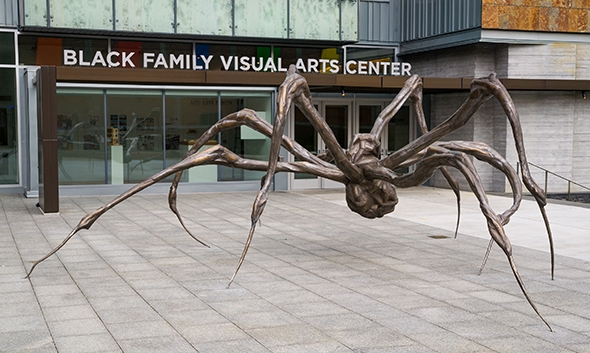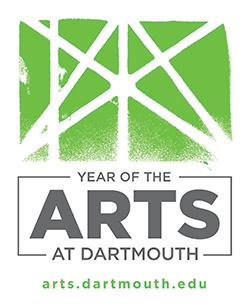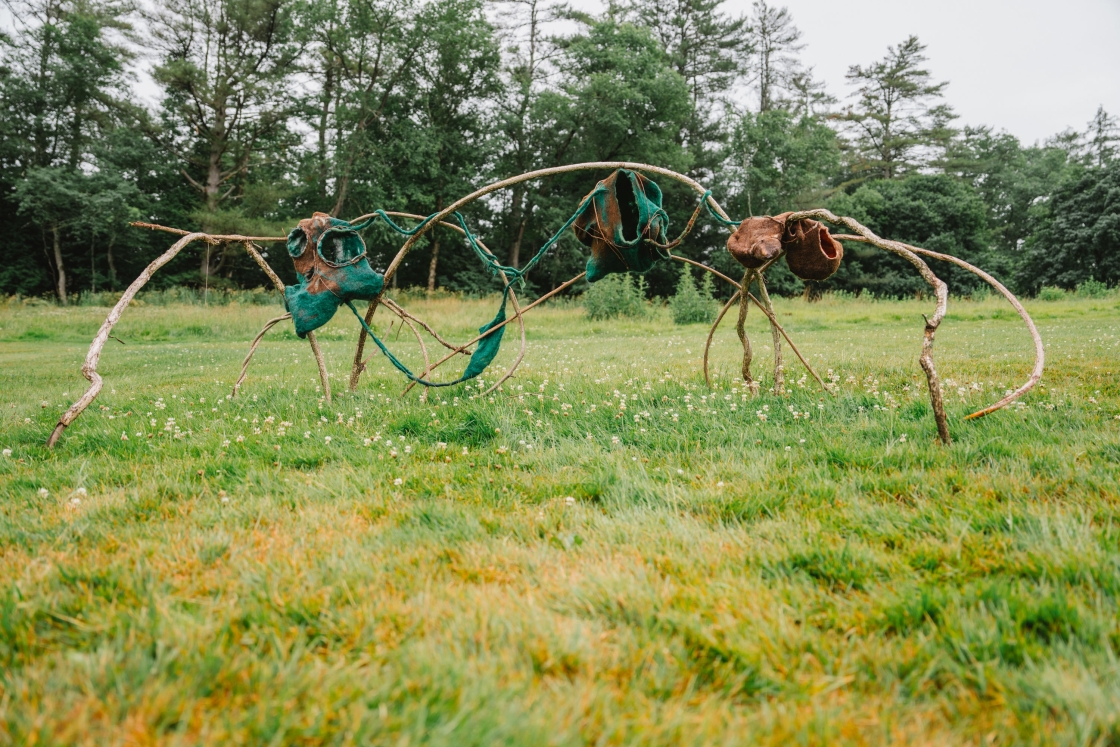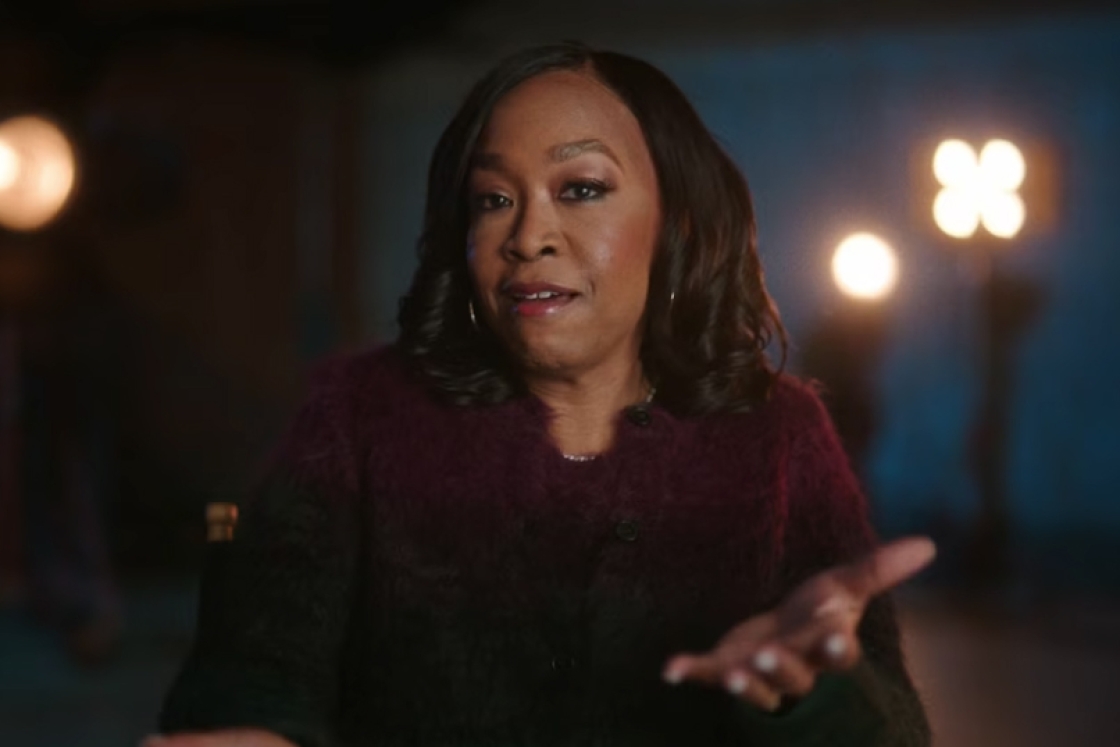A monumental Crouching Spider is on a yearlong loan to Dartmouth from the estate of French-born American artist Louise Bourgeois (1911-2010) as part of the campus-wide Year of the Arts initiative during the 2012-13 academic year. The immense sculpture, 106.5 inches tall and 329 inches wide, is made of bronze, silver nitrate and polished patina, and stainless steel.

Installed September 25 in the Maffei Arts Plaza in front of the new Black Family Visual Arts Center, the sculpture joins a distinguished collection of public art on campus by such internationally recognized artists as Ellsworth Kelly, Mark di Suvero, Allan C. Houser, Beverly Pepper, George Rickey, Richard Serra, and Joel Shapiro.
“Crouching Spider uses metaphors of spinning, weaving, nurture, and protection that are commonly associated with arachnids to allude to the strength, skill, intelligence, and kindness of her beloved mother,” says Michael Taylor, director of the Hood Museum of Art. “According to Louise, it was her mother’s tenacious spirit that inspired her uncompromising vision as a sculptor.”
Taylor, who is also chair of the Public Art Committee at Dartmouth, spoke of “the wonderful synergy and dialogue between Louise Bourgeois’ Crouching Spider and Ellsworth Kelly’s Dartmouth Panels,” which was installed in July on the east façade of the Hopkins Center and overlooks Crouching Spider.
For more than seven decades, Bourgeois followed conflicting psychological and emotional impulses to create intensely autobiographical sculptures that addressed universal themes such as alienation, identity, sexuality, and death.
Born in Paris on Christmas Day, Bourgeois studied mathematics at the Sorbonne, then switched to the study of art in 1932 following the death of her mother. She began her career as a painter but found her true medium after the famous French painter Fernand Léger looked at one of her drawings and presciently told her that she was a sculptor, not a painter. In 1938, Bourgeois married Robert Goldwater, a professor of art and art history at New York University’s Institute of Fine Arts. They moved in 1938 to New York, where she completed her studies at the Art Students League.
Over the next few decades, Bourgeois experimented with a variety of media, including wood, plaster, bronze, latex, and marble, and in doing so developed a unique vocabulary of sculptural forms often related to her psychic demons and personal obsessions. By 1982, when the Museum of Modern Art in New York gave her a major retrospective exhibition, Bourgeois had become recognized as one of the most influential and innovative sculptors of the 20th century. Her reputation as one of the world’s leading contemporary artists was cemented in 1997 when she received the National Medal of Arts from President Clinton.
In the late 1990s, she began creating a series of monumental spider sculptures that are among the most important works of public art to have been created in recent decades. Crouching Spider, which the artist made in 2003, was intended as an ode to her mother, who died when Bourgeois was 21 years old. Bourgeois was first exposed to art as a young child when she helped her mother dye fabrics and repair medieval tapestries in the family’s textile restoration business in Paris.
“She was my best friend,” the artist later recalled. “Like a spider, my mother was a weaver. My family was in the business of tapestry restoration, and my mother was in charge of the workshop. Like spiders, my mother was very clever. Spiders are friendly presences that eat mosquitoes. We know that mosquitoes spread diseases and are therefore unwanted. So, spiders are helpful and protective, just like my mother.”
“It is so exciting to have Crouching Spider here at Dartmouth,” says Brenda Garand, professor of studio art. “This piece is significant not only because it is a major contemporary work, but also because it is the second public sculpture on campus made by a woman artist.” (The first, Thel, is an abstract sculpture by internationally renowned American artist Beverly Pepper, born in 1924. Completed in 1977, Thel sits outside the Sherman Fairchild Physical Sciences Center on campus, rising from the ground in four separate triangular structures. The artist used white for the sculpture to evoke the traditional white buildings and churches of the area and the winter snow.)
Garand continues, “For years I have shown students her work, but a flat image of such a powerful sculpture has always been a poor substitute. Now we will be able to walk around and through the piece, not only looking at it but feeling the impact a sculpture can have upon our bodies and minds.”

The Year of the Arts is a celebration of the excellence of the arts at Dartmouth. Major initiatives this year include the opening of the Black Family Visual Arts Center, the 50th anniversary of the Hopkins Center for the Arts, as well as a yearlong series of interdisciplinary academic programs that explore the intersections between the arts and other disciplines.
Dartmouth has long been a leader in integrating arts into the collegiate experience: from the establishment of one of the nation’s first campus-based performing arts centers, to the commissioning of new works and artist-in-residence programs. The diverse series of arts programs and initiatives this year exemplify Dartmouth’s historic commitment and role as a model for the artistic campus of the 21st century. For more information, please visit arts.dartmouth.edu.
The Year of the Arts is made possible in part by the generous support of the Offices of the President and the Provost at Dartmouth.

